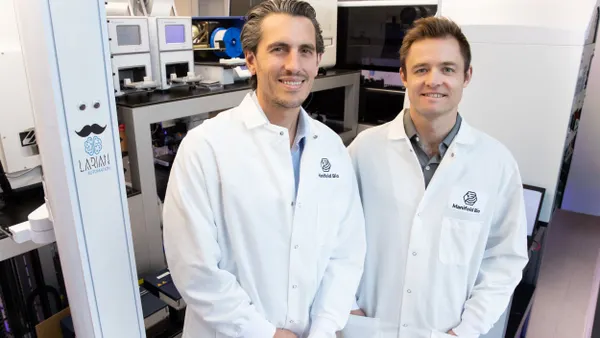View on CME Learning How Doctors Learn: Research to Realism in CME The continuous challenge for providers of professional education, is to understand the learning preferences of practicing clinicians and respond with valuable products and services that are carefully aligned with their needs and preferences. In an exclusive to PharmaVOICE, Anne Goodrich, Director of Research at The Pri-Med Institute, and Joe Panepinto, Ph.D., VP at Pri-Med Online, discuss four key themes for the success of any CME enterprise aimed at practicing clinicians. For anyone involved in continuing medical education, understanding how to engage physicians is a pivotal and ongoing preoccupation. Because doctors are characteristically life-long learners predisposed to taking advantage of meaningful learning opportunities, research is at the core of a process that both frames and continually refines the continuing medical education (CME) experiences presented to primary-care practitioners. Studies encompass a broad range of methodologies, from on-site evaluations of CME programs to national surveys of CME behaviors and preferences to in-depth interviews and multi-market focus groups. Anne Goodrich, director of research at The Pri-Med Institute, and Joe Panepinto, Ph.D., VP of Pri-Med Online, have identified the themes – engagement, learning activity, effectiveness, and accessibility – that are critical for delivering CME programs that meet physicians’ needs. Engagement “The success or failure of any CME program begins with physicians deciding if the activity will be a valuable use of their time, whether that’s attending a medical meeting or visiting a Website,” Ms. Goodrich says. “Understanding the criteria used by primary-care practitioners to select CME opportunities is a vital first step, and this demands analysis of the two primary drivers of participation: logistics and content.” At the most basic level, research is used to identify the key drivers that determine whether a doctor will choose to attend a particular CME program. Physicians make it clear that the accessibility of local and regional meetings is a key factor to their participation, as is the particular day of the week when the program is offered. “As a result, we have witnessed a steady decline in attendance at national medical conventions in recent years,” Dr. Panepinto says. “Physicians also indicate that high return on their time investment – the opportunity to earn substantial CME credits in one intensive clinical program – is a priority.” At the same time, research made it clear that building a truly national CME network would require bringing opportunities closer to where most physicians live and practice and in even more flexible formats. Once accessibility criteria have been met, content becomes the critical driver for attendance. Primary-care practitioners place a premium on clinical curricula that reflect real-world primary-care practice, that addresses a broad spectrum of high-incidence diagnostic and treatment challenges, and target practical solutions they can put into practice immediately. “Research also indicates that primary-care physicians place considerable significance on programs that acknowledge the importance of their mission,” Dr. Panepinto says. To ensure that CME providers have identified the clinical topics that most closely match the primary interests of their target audience, they need to engage in a continuous needs assessment process. “This research is critical to ensuring CME programs are timely, topical, and relevant in their appeal, as well as to identifying any educational priorities that may vary geographically,” Ms. Goodrich says. “We learned, for example, that infectious diseases can be very timely clinical topics in areas where there are very large immigrant populations.” The Learning Activity Effective learning is the outcome of a thoughtfully structured environment. Until fairly recently, counting the number of doctors in seats was generally, if reluctantly, accepted as a measure of performance for a CME program. Today, there is a demand for evidence of active involvement, and CME providers need to deploy insights from research to design the learning process to achieve that purpose. “For primary-care practitioners, an effective learning environment is a blend of expert lectures and case-based presentations, particularly by specialists offering deeper insights into conditions commonly encountered in primary-care practice,” Dr. Panepinto says. As a result, interactive participation has become central to many CME experiences, with participants using electronic audience response systems to register their diagnostic and therapeutic decisions, which they can then compare anonymously with their peers. “To sustain physician interest from year to year, we have found that attendees demand not only a curriculum that mirrors their clinical practice – in the words of one medical director ‘looks like a typical day’s appointment schedule’ – but one that focuses on current updates in diagnostic and treatment approaches,” Dr. Panepinto says. “We now know that, in addition to learning transactions, the CME conference can offer other benefits that attendees find valuable. Peer networking opportunities, a function of local and regional conferences, are viewed as meaningful. The information collected at exhibits supported by commercial sponsors is also seen by a majority of participants as a useful extension of the learning experience.” Attendee participation should also be solicited in the regular collection of feedback, evaluations, and suggestions, stressing the clinician’s role as an active contributor rather than passive spectator in the continuing education experience. This provides a rich stream of research data with which to shape and refine future programs. Effectiveness A far more complex and demanding research question reflects the need to gain insight into the impact of the learning experience itself. “Pharmaceutical companies in making unrestricted educational grants quite reasonably challenge CME providers to produce evidence of return on this investment, or more accurately, of the value created by it,” Ms. Goodrich says. “The question is: what demonstrable impact does CME have on clinical practice?” A variety of research methodologies can be employed to define realistic and useful metrics for measuring the impact of CME programs on physician participants. “Through annual nationwide surveys, we have identified three compelling behavioral measures of the impact of CME programs,” Dr. Panepinto says. “The first is the extent to which clinical guidelines introduced at a CME conference are subsequently employed in clinical practice. The second is self-reported change in knowledge and understanding of the clinical guidelines or standard of care presented at the meeting. And the third is the level of confidence in diagnosing and treating specific conditions in primary-care practice.” There is growing evidence that effective CME programs produce significant shifts in the clinical-practice behavior of primary-care physicians, notably when clinical diagnostic and treatment guidelines are clearly expressed. According to Pri-Med research conducted last year, attendees surveyed four to six weeks after participating in a CME meeting were more likely to incorporate into practice clinical guidelines presented as part of the curriculum than before receiving the education. Specifically, more than 30% reported incorporating new clinical guidelines presented in treating intermittent claudication and benign prostatic hyperplasia. Statistically significant increases also were reported for stress urinary incontinence, gastrointestinal reflux disease (GERD), neuropathic pain, and congestive heart failure. More than 97% of the physicians surveyed reported that they were able to apply the clinical education provided at conferences in their practices. “This study demonstrated that the impact of CME on clinical practice behavior is greatest in conditions where there are not yet widely accepted or uniform guidelines for diagnosis and treatment or where new research and treatment options present alternatives to established guidelines,” Ms. Goodrich says. “Change is least evident in conditions where treatment methods and tools are uniformly well established.” Accessibility The learning needs and preferences of primary-care practitioners are undergoing continuous expansion and change. Research has shown that it is increasingly evident that providing an alternative access channel would be critical to realizing the full potential and educational reach of CME programs on key clinical topics in primary care. Some physicians simply do not choose live meetings as a source of CME. Others simply cannot free up the time from their practices to participate in a face-to-face conference. At the same time, continuing educational needs are often driven by presenting patients and emerge in the spaces between scheduled medical meetings. According to Dr. Panepinto, at first glance, eCME might be viewed as a competitor to live events, but Pri-Med research has shown a spike of 25% in online CME usage since last year. “Secondary research convinced us that eCME would eventually play a significant role in CME,” Dr. Panepinto says. “Latent demand was clearly present, and inherent flexibility offered important value to doctors. Through in-depth interviews across the United States, we probed physicians’ views on existing medical sites offering CME, identifying needs that they felt were not being met. Further research among physician attendees led to two conclusions. The first was that eCME could become a highly effective education channel, but was currently long on promise and short on substance. Second, a central role of eCME, perhaps the central role, would be as an adjunct and complement to live medical meetings, not as a substitute. An effective eCME channel would lead to more physician involvement in CME, which is consistent with media consumption patterns in general.” The hype surrounding early Web-based CME has not matched mundane realities. Content consisted largely of type transferred from paper to screen. Live Webcasts and streaming video were offered to an audience, who, for the most part, lacked broadband connections. Research would have shown that few doctors could schedule their time around live Webcasts, and that in fact this removed one of the key benefits of online education – its 24/7, on-demand availability. “Research shows that online CME programs are accessed primarily outside of work hours, and to a considerable extent, logging on for CME information is triggered by questions presented in the practice,” Ms. Goodrich says. “We learned that physicians log onto a site for different purposes at different times. Two key variables are time available and depth of interest. At one time, the physician may log in to review a patient case study for insight to support a diagnostic or treatment decision or to download patient education materials. At another, it may be to follow a clinical lecture, read an expert opinion, or research a topic.” Usability becomes the pivotal factor in the success or failure of an eCME site. Experts agree that it is critical to recognize that an eCME portal will serve as the exclusive, or even principal, source of CME for only a fraction of the physician universe. For the majority, it will be the source of some CME programs and credits, and it will serve as an addition to live meetings, peer-reviewed journals, and enduring materials. “Recognizing this, it is clearly not enough to simply replicate the content of conference programs, but to use that content as a core that can be expanded and continually updated online,” Dr. Panepinto says. Today, the marriage of eCME with traditional medical education forums brings into view an important and long-elusive goal: the possibility of communicating with physicians as professionals and, at the same time, one by one. “This will enable astute researchers to tap into a pool of feedback expanding both quantitatively and qualitatively and align continuing medical education more closely with the needs and interests of individual physicians,” Ms. Goodrich says. “The industry is indeed learning how doctors learn, with the goal of making the role of continuing medical education more vital to the practice of medicine, and more valuable in its contribution to enhanced patient care.”F PharmaVoice welcomes comments about this article. E-mail us at [email protected]. Understanding the criteria used by primary-care practitioners to select CME opportunities is a vital first step that demands analysis of the two primary drivers of participation: logistics and content. For primary-care practitioners, an effective learning environment is a blend of expert lectures and case-based presentations, particularly by specialists offering deeper insights into conditions commonly encountered in primary-care practice. Doctors said they would turn readily to an eCME site that met these key criteria A site designed specifically for physicians and not for other health professionals or consumers Comprehensive in scope, yet uncluttered and easy to use and navigate Multiple learning modes, including interactive case-based presentations, clinical lectures, and expert perspectives Depth of content and quick answers Ability to log off and resume at the precise point of departure Gateways to recognized treatment guidelines, medical literature, patient education materials, and news updates
An article from


Learning How Doctors Learn: Research to Realism in CME
Filed Under:
Research & Development









